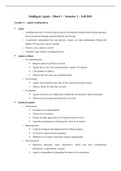Intelligent Agents – Block 1 – Semester 1 – Fall 2021
Lecture 1 – Agent Architectures
• Agent:
o Anything that can be viewed as perceiving its environment through sensors and acting upon
that environment through actuators (Russel and Norvig)
o A persistent computation that can perceive, reason, act and communicate (Singh and
Huhns) → long term, always learning
o Sensors: eyes, cameras, sensors
o Actuators: legs, motors, messaging devices
• Agent vs. Object:
o In communication:
▪ Request agents to perform an action
▪ Agents have a two-way communication: request → response
▪ Call methods of objects
▪ Objects only have one-way communication
o In reasoning:
▪ Agents reason based on the state of the world and perform actions
▪ Objects always do what they are told
o In adapting:
▪ Agents can learn to act differently in different circumstances and environment
▪ Objects do not change their behaviour over time
• Features of agents:
o Autonomous
▪ Freedom to act independently
▪ Choose its own actions
▪ Decide on other agents that it will interact with or to trust
▪ Generally autonomous in choosing the extent of its actions
o Heterogeneous
▪ Could be designed and implemented by different parties
▪ No need to expose internal properties
▪ Might have to comply with some common requirements
o Self-interested
▪ Represent principals (users, businesses), which may have contradicting
preferences, commitments, or goals
▪ Agent is responsible for promoting the interest of its principals
,• Generic agent architecture:
o Environment can be in one of the following states:
▪ S = {s0, s1, ..., sN}
▪ Indicated by the conditions and context of the environment where the agent is in
o The agent can do one of the given actions:
▪ A = {a0, a1, ..., aN}
▪ E.g., beeping, displaying, no-op, waiting etc.
o Deterministic behaviour: Takes a sequence of states and determines the action to take
▪ E.g., from State1 can only go to State2
o The actions can be non-deterministic:
▪ E.g., from State1 can go to State2 but also to State3
• Rational agents:
o Always aims to perform optimal actions based on given premises and information
o Premises: what the agent perceived so far and what the agent already knows about the
environment
o Ideally: for each possible percept sequence, it acts to maximize its expected utility, based
on its knowledge and the evidence from the percept sequence
• Reflex agents:
o Act only based on the current percept, ignoring the rest of the percept history
o Agent function is based on the condition-action rule:
▪ "if condition, then action"
▪ This only succeeds when the environment is fully observable; infinite loops are
often unavoidable in partially observable environments
▪ E.g., thermostat: “if temperature < 15 degrees, then turn heating on”
• Model-based reflex agents:
o How the world evolves is a model of the world
o Remember the past through internal state
, o Has an internal model of "how the world works and looks like" holding information of the
unobserved aspects of a given state which depends on the percept history
o Percept history and impact of action on the environment can be determined by using the
internal model
• Goal-based agents:
o Identify (goal) state(s) where the goal holds
o Perform actions that will take the agent to a goal (desirable) state
o States and goals should be compatible
o Only distinguishes between goal states and non-goal states
o If a sequence of actions is necessary, plan
▪ E.g., goal is to obtain a MS degree, then study, pass exams and receive credits
o Goal types:
▪ Perform: related to an action
▪ Achieve: satisfy a desired condition
▪ Maintain: continue to establish a condition
▪ Query: obtain piece of information
, o Goal operations:
▪ Adopt: based on intentions
▪ Activate: start working on it (e.g., executing plans)
▪ Suspend: delay (e.g., another goal has a priority)
▪ Drop: remove the goal list all together (e.g., not important anymore or not
attainable)
• Utility-based agents:
o Idea is to define a measure of how desirable a particular state is (no notion of a goal here):
▪ This measure can be obtained using a utility function which maps a state to a
measure of the utility of the state
▪ Term utility can be used to describe how "happy" the agent is
o It enables comparison between states even when none are perfect or more than one good
state exists
o It chooses the action that maximizes the expected utility of the action outcomes (i.e., what
the agent expects to derive given the probabilities and utilities of each outcome)
o It must model and keep track of its environment
• BDI agents:
o Beliefs:
▪ Agent’s beliefs about the world (including itself and other agents)
▪ Can include inference rules, allowing forward chaining to lead to new beliefs
▪ What an agent believes may not necessarily be true (and in fact may change in the
future)
▪ Revising beliefs:
• Why? Agent may perceive information that contradicts old belief
• E.g., current belief: course ends at 15:00; talk to a friend who says it ends
at 15:15
• How?
o New belief overrides old belief
o Keep both old and new belief but handle inconsistency
o Assign probabilities
o Desires:
▪ The set of states that the agent would like to be in (may be inconsistent), the
motivational state of the agent
▪ Represent objectives or situations that the agent would like to accomplish or bring
about
▪ E.g., find best price, go to party, become rich





